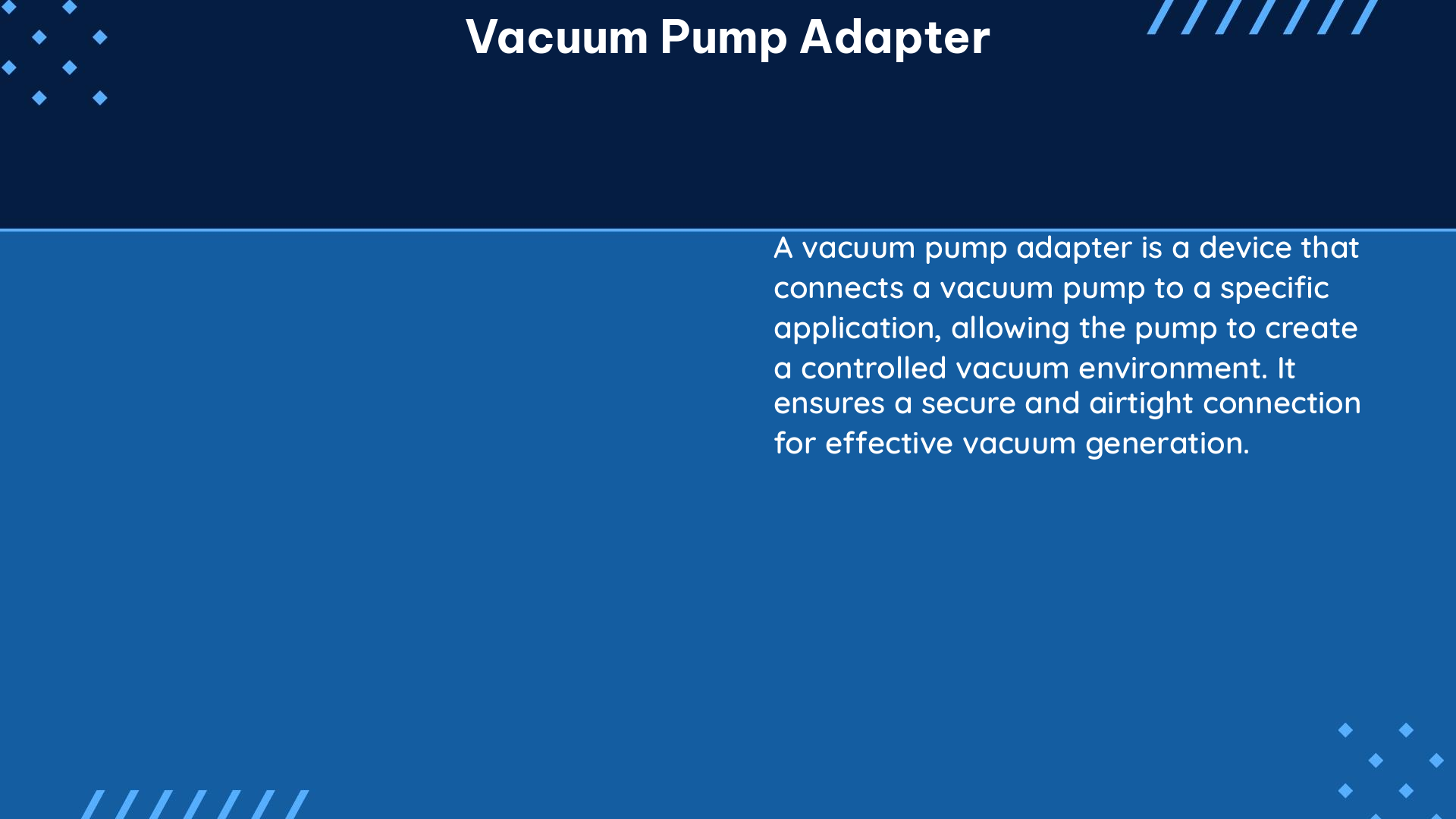A vacuum pump adapter is a crucial component that connects a vacuum pump to various equipment, enabling the creation of a controlled vacuum environment. These adapters come in diverse sizes, materials, and pressure ratings, catering to a wide range of applications. Whether you’re a DIY enthusiast or a professional, understanding the intricacies of vacuum pump adapters is essential for ensuring a successful and efficient setup.
Understanding Vacuum Pump Adapter Measurements and Specifications
Thread Size
The thread size of a vacuum pump adapter is a critical measurement that determines the compatibility with the vacuum pump and the equipment it is being connected to. This size is typically expressed in inches, using the National Pipe Thread (NPT) system. Common thread sizes for vacuum pump adapters include 1/4″ NPT, 3/8″ NPT, and 1/2″ NPT. Ensuring the correct thread size is crucial to ensure a secure and leak-free connection.
Inside Diameter (ID) and Outside Diameter (OD)
The inside diameter (ID) and outside diameter (OD) of a vacuum pump adapter are equally important measurements. The ID determines the size of the hose or tubing that can be connected to the adapter, while the OD affects the overall fit and compatibility with the equipment. Typical ID sizes range from 6 mm (0.24 inches) to 25 mm (0.98 inches), while OD sizes can vary from 1/4 inch to 1 inch.
Material Composition
The material composition of a vacuum pump adapter is crucial in determining its suitability for specific applications. Common materials used in vacuum pump adapters include:
- Stainless Steel: Offers excellent corrosion resistance and durability, making it suitable for high-temperature or chemically-demanding environments.
- Brass: Provides good strength and corrosion resistance, making it a popular choice for general-purpose applications.
- Aluminum: Lightweight and corrosion-resistant, aluminum adapters are often used in portable or mobile setups.
- Plastic (e.g., PVC, PTFE): Lightweight and chemically-resistant, plastic adapters are suitable for less demanding applications.
The choice of material should be based on the specific requirements of the application, such as temperature, chemical exposure, and overall durability needs.
Pressure Rating
The pressure rating of a vacuum pump adapter is a crucial specification that determines the maximum vacuum pressure the adapter can safely handle. This rating is typically expressed in inches of mercury (inHg) or pounds per square inch (psi). Common pressure ratings for vacuum pump adapters range from 20 inHg (-6.7 psi) to 30 inHg (-14.7 psi), with some high-performance adapters capable of handling even lower pressures.
Selecting the Right Vacuum Pump Adapter

When choosing a vacuum pump adapter, consider the following factors:
- Compatibility: Ensure that the thread size, ID, and OD of the adapter match the specifications of both the vacuum pump and the equipment it will be connected to.
- Material Suitability: Select an adapter made of a material that can withstand the temperature, chemical, and environmental conditions of your application.
- Pressure Rating: Ensure that the adapter’s pressure rating is suitable for the vacuum pressure requirements of your setup.
- Hose or Tubing Compatibility: Verify that the adapter’s ID or OD matches the size of the hose or tubing you plan to use.
- Ease of Installation: Consider the adapter’s design and features, such as swivel fittings or quick-connect couplings, to simplify the installation process.
DIY Vacuum Pump Adapter Fabrication
For DIY enthusiasts, it is possible to create custom vacuum pump adapters using readily available fittings and components. This approach requires a thorough understanding of the measurements and specifications of the vacuum pump and the equipment it will be connected to. When fabricating a DIY vacuum pump adapter, consider the following steps:
- Determine the Required Measurements: Carefully measure the thread size, ID, and OD of the vacuum pump and the equipment you’ll be connecting.
- Select Appropriate Components: Visit your local hardware store or search online for fittings, adapters, and tubing that match the required measurements.
- Assemble the Adapter: Use appropriate tools, such as wrenches and thread sealants, to assemble the components into a functional vacuum pump adapter.
- Test and Validate: Conduct a thorough leak test to ensure the adapter’s integrity and proper functioning under vacuum conditions.
Remember, when fabricating a DIY vacuum pump adapter, it’s crucial to use high-quality components and follow best practices to ensure a safe and reliable setup.
Conclusion
Vacuum pump adapters are essential components that enable the creation of controlled vacuum environments. By understanding the various measurements, specifications, and material considerations, you can select or fabricate the perfect vacuum pump adapter for your specific needs. Whether you’re a DIY enthusiast or a professional, this comprehensive guide will help you navigate the world of vacuum pump adapters and ensure a successful and efficient setup.
References:
- TSQ Series – Hardware Manual – Thermo Fisher Scientific
- Vacuum pump hose size/adapter? – HVAC-Talk
- Vacuum Pump Adapters – McMaster-Carr

The lambdageeks.com Core SME Team is a group of experienced subject matter experts from diverse scientific and technical fields including Physics, Chemistry, Technology,Electronics & Electrical Engineering, Automotive, Mechanical Engineering. Our team collaborates to create high-quality, well-researched articles on a wide range of science and technology topics for the lambdageeks.com website.
All Our Senior SME are having more than 7 Years of experience in the respective fields . They are either Working Industry Professionals or assocaited With different Universities. Refer Our Authors Page to get to know About our Core SMEs.